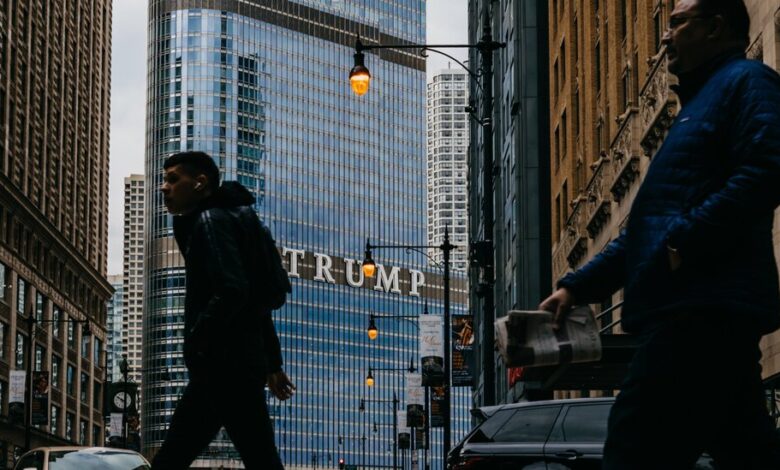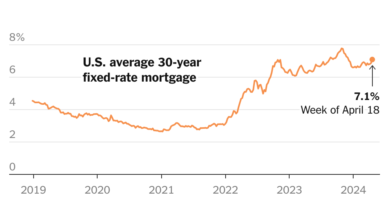Trump May Owe $100 Million From Double-Dip Tax Breaks, Audit Shows

Former President Donald J. Trump used a dubious accounting maneuver to claim improper tax breaks from his troubled Chicago tower, according to an Internal Revenue Service inquiry uncovered by The New York Times and ProPublica. Losing a yearslong audit battle over the claim could mean a tax bill of more than $100 million.
The 92-story, glass-sheathed skyscraper along the Chicago River is the tallest and, at least for now, the last major construction project by Mr. Trump. Through a combination of cost overruns and the bad luck of opening in the teeth of the Great Recession, it was also a vast money loser.
But when Mr. Trump sought to reap tax benefits from his losses, the I.R.S. has argued, he went too far and in effect wrote off the same losses twice.
The first write-off came on Mr. Trump’s tax return for 2008. With sales lagging far behind projections, he claimed that his investment in the condo-hotel tower met the tax code definition of “worthless,” because his debt on the project meant he would never see a profit. That move resulted in Mr. Trump reporting losses as high as $651 million for the year, The Times and ProPublica found.
There is no indication the I.R.S. challenged that initial claim, though that lack of scrutiny surprised tax experts consulted for this article. But in 2010, Mr. Trump and his tax advisers sought to extract further benefits from the Chicago project, executing a maneuver that would draw years of inquiry from the I.R.S. First, he shifted the company that owned the tower into a new partnership. Because he controlled both companies, it was like moving coins from one pocket to another. Then he used the shift as justification to declare $168 million in additional losses over the next decade.
The issues around Mr. Trump’s case were novel enough that, during his presidency, the I.R.S. undertook a high-level legal review before pursuing it. The Times and ProPublica, in consultation with tax experts, calculated that the revision sought by the I.R.S. would create a new tax bill of more than $100 million, plus interest and potential penalties.
Mr. Trump’s tax records have been a matter of intense speculation since the 2016 presidential campaign, when he defied decades of precedent and refused to release his returns, citing a long-running audit. A first, partial revelation of the substance of the audit came in 2020, when The Times reported that the I.R.S. was disputing a $72.9 million tax refund that Mr. Trump had claimed starting in 2010. That refund, which appeared to be based on Mr. Trump’s reporting of vast losses from his long-failing casinos, equaled every dollar of federal income tax he had paid during his first flush of television riches, from 2005 through 2008, plus interest.
The reporting by The Times and ProPublica about the Chicago tower reveals a second component of Mr. Trump’s quarrel with the I.R.S. This account was pieced together from a collection of public documents, including filings from the New York attorney general’s suit against Mr. Trump in 2022, a passing reference to the audit in a congressional report that same year and an obscure 2019 I.R.S. memorandum that explored the legitimacy of the accounting maneuver. The memorandum did not identify Mr. Trump, but the documents, along with tax records previously obtained by The Times and additional reporting, indicated that the former president was the focus of the inquiry.
It is unclear how the audit battle has progressed since December 2022, when it was mentioned in the congressional report. Audits often drag on for years, and taxpayers have a right to appeal the I.R.S.’s conclusions. The case would typically become public only if Mr. Trump chose to challenge a ruling in court.
In response to questions for this article, Mr. Trump’s son Eric, executive vice president of the Trump Organization, said: “This matter was settled years ago, only to be brought back to life once my father ran for office. We are confident in our position, which is supported by opinion letters from various tax experts, including the former general counsel of the I.R.S.”
An I.R.S. spokesman said federal law prohibited the agency from discussing private taxpayer information.
The outcome of Mr. Trump’s dispute could set a precedent for wealthy people seeking tax benefits from the laws governing partnerships. Those laws are notoriously complex, riddled with uncertainty and under constant assault by lawyers pushing boundaries for their clients. The I.R.S. has inadvertently further invited aggressive positions by rarely auditing partnership tax returns.
The audit represents yet another potential financial threat — albeit a more distant one — for Mr. Trump, the Republicans’ presumptive 2024 presidential nominee. In recent months, he has been ordered to pay $83.3 million in a defamation case and another $454 million in a civil fraud case brought by the New York attorney general, Letitia James. Mr. Trump has appealed both judgments. (He is also in the midst of a criminal trial in Manhattan, where he is accused of covering up a hush-money payment to a porn star in the weeks before the 2016 election.)
Beyond the two episodes under audit, reporting by The Times in recent years has found that, across his business career, Mr. Trump has often used what experts described as highly aggressive — and at times, legally suspect — accounting maneuvers to avoid paying taxes. To the six tax experts consulted for this article, Mr. Trump’s Chicago accounting maneuvers appeared to be questionable and unlikely to withstand scrutiny.
“I think he ripped off the tax system,” said Walter Schwidetzky, a law professor at the University of Baltimore and an expert on partnership taxation.
From ‘$1.2 Billion’ to ‘Worthless’
Mr. Trump struck a deal in 2001 to acquire land and a building that was then home to the Chicago Sun-Times newspaper. Two years later, after publicly toying with the idea of constructing the world’s tallest building there, he unveiled plans for a more modest tower, with 486 residences and 339 “hotel condominiums” that buyers could use for short stays and allow Mr. Trump’s company to rent out. He initially estimated that construction would last until 2007 and cost $650 million.
Mr. Trump placed the project at the center of the first season of “The Apprentice” in 2004, offering the winner a top job there under his tutelage. “It’ll be a mind-boggling job to manage,” Mr. Trump said during the season finale. “When it’s finished in 2007, the Trump International Hotel and Tower, Chicago, could have a value of $1.2 billion and will raise the standards of architectural excellence throughout the world.”
As his cost estimates increased, Mr. Trump arranged to borrow as much as $770 million for the project — $640 million from Deutsche Bank and $130 million from Fortress Investment Group, a hedge fund and private equity company. He personally guaranteed $40 million of the Deutsche loan. Both Deutsche and Fortress then sold off pieces of the loans to other institutions, spreading the risk and potential gain.
Mr. Trump planned to sell enough of the 825 units to pay off his loans when they came due in May 2008. But when that date came, he had sold only 133. At that point, he projected that construction would not be completed until mid-2009, at a revised cost of $859 million.
He asked his lenders for a six-month extension. A briefing document prepared for the lenders, obtained by The Times and ProPublica, said Mr. Trump would contribute $89 million of his own money, $25 million more than his initial plan. The lenders agreed.
But sales did not pick up that summer, with the nation plunged into the financial crisis that would become the Great Recession. When Mr. Trump asked for another extension in September, his lenders refused.
Two months later, Mr. Trump defaulted on his loans and sued his lenders, characterizing the financial crisis as the kind of catastrophe, like a flood or hurricane, covered by the “force majeure” clause of his loan agreement with Deutsche Bank. That, he said, entitled him to an indefinite delay in repaying his loans. Mr. Trump went so far as to blame the bank and its peers for “creating the current financial crisis.” He demanded $3 billion in damages.
At the time, Mr. Trump had paid down his loans with $99 million in sales but still needed more money to complete construction. At some point that year, he concluded that his investment in the tower was worthless, at least as the term is defined in partnership tax law.
Mr. Trump’s worthlessness claim meant only that his stake in 401 Mezz Venture, the L.L.C. that held the tower, was without value because he expected that sales would never produce enough cash to pay off the mortgages, let alone turn a profit.
When he filed his 2008 tax return, he declared business losses of $697 million. Tax records do not fully show which businesses generated that figure. But working with tax experts, The Times and ProPublica calculated that the Chicago worthlessness deduction could have been as high as $651 million, the value of Mr. Trump’s stake in the partnership — about $94 million he had invested and the $557 million loan balance reported on his tax returns that year.
When business owners report losses greater than their income in any given year, they can retain the leftover negative amount as a credit to reduce their taxable income in future years. As it turned out, that tax-reducing power would be of increasing value to Mr. Trump. While many of his businesses continued to lose money, income from “The Apprentice” and licensing and endorsement agreements poured in: $33.3 million in 2009, $44.6 million in 2010 and $51.3 million in 2011.
Mr. Trump’s advisers girded for a potential audit of the worthlessness deduction from the moment they claimed it, according to the filings from the New York attorney general’s lawsuit. Starting in 2009 Mr. Trump’s team excluded the Chicago tower from the frothy annual “statements of financial condition” that Mr. Trump used to boast of his wealth, out of concern that assigning value to the building would conflict with its declared worthlessness, according to the attorney general’s filing. (Those omissions came even as Mr. Trump fraudulently inflated his net worth to qualify for low-interest loans, according to the ruling in the attorney general’s lawsuit.)
Mr. Trump had good reason to fear an audit of the deduction, according to the tax experts consulted for this article. They believe that Mr. Trump’s tax advisers pushed beyond what was defensible.
The worthlessness deduction serves as a way for a taxpayer to benefit from an expected total loss on an investment long before the final results are known. It occupies a fuzzy and counterintuitive slice of tax law. Three decades ago, a federal appeals court ruled that the judgment of a company’s worthlessness could be based in part on the opinion of its owner. After taking the deduction, the owner can keep the “worthless” company and its assets. Subsequent court decisions have only partly clarified the rules. Absent prescribed parameters, tax lawyers have been left to handicap the chances that a worthlessness deduction will withstand an I.R.S. challenge.
There are several categories, with a declining likelihood of success, of money taxpayers can claim to have lost.
The tax experts consulted for this article universally assigned the highest level of certainty to cash spent to acquire an asset. The roughly $94 million that Mr. Trump’s tax returns show he invested in Chicago fell into this category.
Some gave a lower, though still probable, chance of a taxpayer prevailing in declaring a loss based on loans that a lender agreed to forgive. That’s because forgiven debt generally must be declared as income, which can offset that portion of the worthlessness deduction in the same year. A large portion of Mr. Trump’s worthlessness deduction fell in this category, though he did not begin reporting forgiven debt income until two years later, a delay that would have further reduced his chances of prevailing in an audit.
The tax experts gave the weakest chance of surviving a challenge for a worthlessness deduction based on borrowed money for which the outcome was not clear. It reflects a doubly irrational claim — that the taxpayer deserves a tax benefit for losing someone else’s money even before the money has been lost, and that those anticipated future losses can be used to offset real income from other sources. Most of the debt included in Mr. Trump’s worthlessness deduction was based on that risky position.
Including that debt in the deduction was “just not right,” said Monte Jackel, a veteran of the I.R.S. and major accounting firms who often publishes analyses of partnership tax issues.
A Second Bite at the Apple
Mr. Trump continued to sell units at the Chicago Tower, but still below his costs. Had he done nothing, his 2008 worthlessness deduction would have prevented him from claiming that shortfall as losses again. But in 2010, his lawyers attempted an end-run by merging the entity through which he owned the Chicago tower into another partnership, DJT Holdings L.L.C. In the following years, they piled other businesses, including several of his golf courses, into DJT Holdings.
Those changes had no apparent business purpose. But Mr. Trump’s tax advisers took the position that pooling the Chicago tower’s finances with other businesses entitled him to declare even more tax-reducing losses from his Chicago investment.
His financial problems there continued. More than 100 of the hotel condominiums never sold. Sales of all units totaled only $727 million, far below Mr. Trump’s budgeted costs of $859 million. And some 70,000 square feet of retail space remained vacant because it had been designed without access to foot or vehicle traffic. From 2011 through 2020, Mr. Trump reported $168 million in additional losses from the project.
Those additional write-offs helped Mr. Trump avoid tax liability for his continuing entertainment riches, as well as his unpaid debt from the tower. Starting in 2010, his lenders agreed to forgive about $270 million of those debts. But he was able to delay declaring most of that income until 2014 and spread it out over five years of tax returns, thanks to a provision in the Obama administration’s stimulus bill responding to the Great Recession. In 2018, Mr. Trump reported positive income for the first time in 11 years. But his income tax bill still amounted to only $1.9 million, even as he reported a $25 million gain from the sale of his late father’s assets.
It’s unclear when the I.R.S. began to question the 2010 merger transaction, but the conflict escalated during Mr. Trump’s presidency.
The I.R.S. explained its position in a Technical Advice Memorandum, released in 2019, that identified Mr. Trump only as “A.” Such memos, reserved for cases where the law is unclear, are rare and involve extensive review by senior I.R.S. lawyers. The agency produced only two other such memos that year.
The memos are required to be publicly released with the taxpayer’s information removed, and this one was more heavily redacted than usual. Some partnership specialists wrote papers exploring its meaning and importance to other taxpayers, but none identified taxpayer “A” as the then-sitting president of the United States. The Times and ProPublica matched the facts of the memo to information from Mr. Trump’s tax returns and elsewhere.
The 20-page document is dense with footnotes, calculations and references to various statutes, but the core of the I.R.S.’s position is that Mr. Trump’s 2010 merger violated a law meant to prevent double dipping on tax-reducing losses. If done properly, the merger would have accounted for the fact that Mr. Trump had already written off the full cost of the tower’s construction with his worthlessness deduction.
In the I.R.S. memo, Mr. Trump’s lawyers vigorously disagreed with the agency’s conclusions, saying he had followed the law.
If the I.R.S. prevails, Mr. Trump’s tax returns would look very different, especially those from 2011 to 2017. During those years, he reported $184 million in income from “The Apprentice” and agreements to license his name, along with $219 million from canceled debts. But he paid only $643,431 in income taxes thanks to huge losses on his businesses, including the Chicago tower. The revisions sought by the I.R.S. would require amending his tax returns to remove $146 million in losses and add as much as $218 million in income from condominium sales. That shift of up to $364 million could swing those years out of the red and well into positive territory, creating a tax bill that could easily exceed $100 million.
The only public sign of the Chicago audit came in December 2022, when a congressional Joint Committee on Taxation report on I.R.S. efforts to audit Mr. Trump made an unexplained reference to the section of tax law at issue in the Chicago case. It confirmed that the audit was still underway and could affect Mr. Trump’s tax returns from several years.
That the I.R.S. did not initiate an audit of the 2008 worthlessness deduction puzzled the experts in partnership taxation. Many assumed the understaffed I.R.S. simply had not realized what Mr. Trump had done until the deadline to investigate it had passed.
“I think the government recognized that they screwed up,” and then audited the merger transaction to make up for it, Mr. Jackel said.
The agency’s difficulty in keeping up with Mr. Trump’s maneuvers, experts said, showed that this gray area of tax law was too easy to exploit.
“Congress needs to radically change the rules for the worthlessness deduction,” Professor Schwidetzky said.
Susanne Craig contributed reporting.



